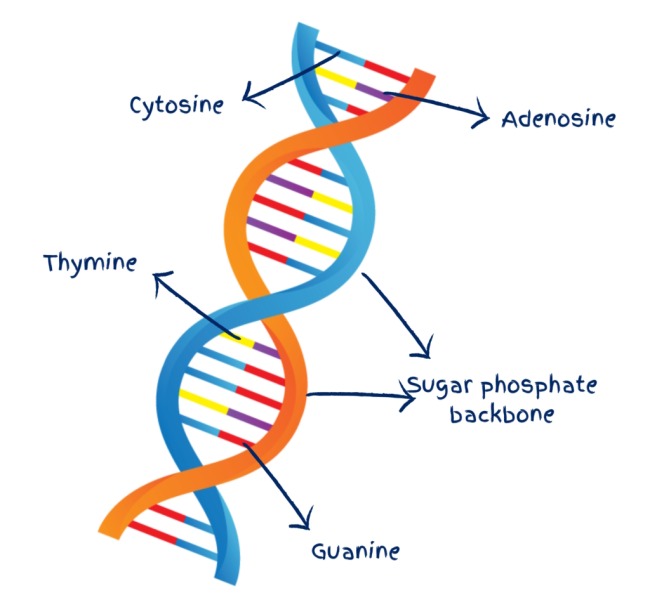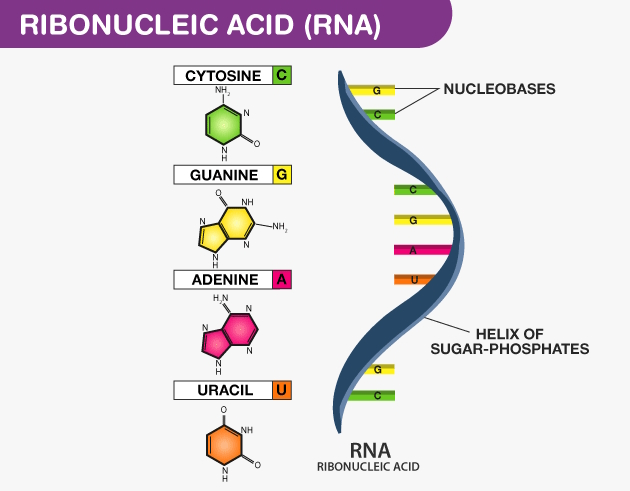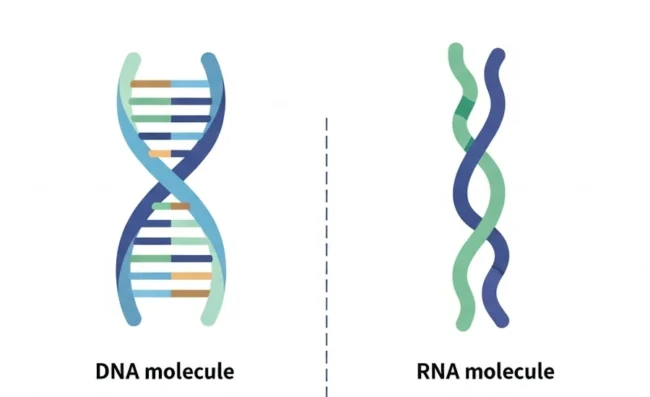Within the microscopic world of our cells lies an extraordinary system of molecular instruction and communication. At the heart of this system are two remarkable molecules: DNA (deoxyribonucleic acid) and RNA (ribonucleic acid). While both are nucleic acids essential for life as we know it, the difference between DNA and RNA encompasses everything from their chemical structure to their primary functions in the cell. Understanding these differences helps us grasp how our genetic information is stored, expressed, and transmitted.
- What’s the difference between DNA and RNA?
- What is the structural difference?
- Chemical differences
- Functional difference between DNA and RNA
- Difference between DNA and RNA as genetic material
- Differences in proteins
- What are the similarities?
- Differences on biological level
- What is significant for medicine and biotechnology?
- Summarizing: 15 main differences
What’s the difference between DNA and RNA?
The main differences between DNA and RNA can be summarized in several key aspects:
- Structure: DNA is typically double-stranded, forming the famous double helix, while RNA is usually single-stranded.
- The sugar found in DNA is deoxyribose, whereas RNA contains ribose as its sugar component.
- Nitrogenous bases: DNA uses adenine (A), guanine (G), cytosine (C), and thymine (T), while RNA uses adenine (A), guanine (G), cytosine (C), and uracil (U) instead of thymine.
- Stability: DNA is more stable and less prone to degradation than RNA.
- Location: DNA is primarily found in the nucleus (in eukaryotes), while RNA can be found throughout the cell.
- Function: DNA stores genetic information, while RNA serves various roles in protein synthesis and other cellular processes.
Let’s explore each of these differences in greater detail.
What is the structural difference?
The double helix vs. single strand
A major difference between DNA and RNA is their overall structure. DNA typically exists as a double-stranded molecule, with two complementary strands coiled around each other in the iconic double helix shape. This structure, first described by James Watson and Francis Crick in 1953, provides stability and protection for the genetic information within.
RNA, on the other hand, is usually single-stranded. This single-stranded nature gives RNA greater flexibility, allowing it to fold into complex three-dimensional structures by forming intramolecular base pairs. This structural flexibility is crucial for RNA’s diverse functions in the cell.
Sugar backbone variations
One structural difference between DNA and RNA lies in their sugar components. DNA contains 2′-deoxyribose, while RNA contains ribose. The key distinction is the presence of a hydroxyl group (-OH) at the 2′ position of the ribose sugar in RNA, which is absent in DNA (hence “deoxy”). This seemingly small difference has significant implications for the stability and function of these molecules.
Chemical differences
Sugar composition
From a chemistry perspective, the difference between DNA and RNA according to chemistry begins with their sugar components:
- DNA contains 2′-deoxyribose (C₅H₁₀O₄)
- RNA contains ribose (C₅H₁₀O₅)
The additional hydroxyl group in RNA’s ribose makes it more reactive and less stable than DNA, which is one reason why DNA, rather than RNA, evolved as the primary storage molecule for genetic information.

Nitrogenous bases
Another key chemical difference involves the nitrogenous bases:
- DNA uses: Adenine (A), Guanine (G), Cytosine (C), and Thymine (T)
- RNA uses: Adenine (A), Guanine (G), Cytosine (C), and Uracil (U)
The replacement of thymine with uracil in RNA represents another chemical difference. Uracil shares a similar structure with thymine but differs by the absence of a methyl group. This substitution makes RNA production more energy-efficient, as uracil requires less energy to synthesize than thymine.

Phosphodiester bonds and pH sensitivity
Both DNA and RNA have phosphodiester bonds connecting their nucleotide units, but the additional hydroxyl group in RNA’s ribose makes these bonds more susceptible to alkaline hydrolysis. This chemical property makes RNA more easily degraded in alkaline conditions, whereas DNA is more resistant.
Functional difference between DNA and RNA
The three differences between DNA and RNA are particularly evident in their functional roles within the cell:
DNA: the storage archive
DNA serves as the primary genetic repository, storing the complete set of instructions needed to build and maintain an organism. Its stability and error-checking mechanisms make it ideal for long-term information storage.
RNA: the versatile messenger and worker
RNA plays multiple roles in the cell:
- Messenger RNA (mRNA): Carries genetic information from DNA to ribosomes for protein synthesis
- Transfer RNA (tRNA) carries amino acids to the ribosomes, facilitating protein assembly.
- Ribosomal RNA (rRNA): Forms part of the structure of ribosomes
- Non-coding RNAs: Perform various regulatory functions, including gene expression control
This functional diversity is possible due to RNA’s structural flexibility and its ability to interact with both DNA and proteins.
Difference between DNA and RNA as genetic material
When considering the difference between DNA and RNA as genetic material, it’s important to note that while DNA is the predominant genetic material in most organisms, RNA serves as the primary genetic material in some viruses, such as influenza and coronaviruses.
The main differences between DNA and RNA are particularly relevant in this context:
- Stability: DNA’s double-stranded structure and chemical composition make it more stable and suitable for long-term storage of genetic information.
- Error Correction: DNA replication involves sophisticated error-checking mechanisms, resulting in lower mutation rates compared to RNA replication.
- Evolutionary Adaptation: RNA viruses can evolve rapidly due to higher mutation rates, allowing them to adapt quickly to new environments and evade host immune responses.
- Ancient Origins: The “RNA world” hypothesis suggests that RNA may have preceded DNA as the original genetic material in early life forms, serving both as genetic material and as enzymes (ribozymes).
Differences in proteins
Understanding the difference between DNA and RNA and protein is crucial for grasping the Central Dogma of molecular biology:
- DNA serves as the blueprint, containing the genetic instructions.
- RNA acts as the messenger and facilitator, carrying and interpreting these instructions.
- Proteins are the final products, performing most cellular functions.
This relationship is often summarized as “DNA makes RNA makes protein,” though we now know there are many nuances and exceptions to this simplified model.
The process of gene expression
- Transcription: DNA is transcribed into RNA in the nucleus.
- Processing: In eukaryotes, the primary RNA transcript undergoes modifications, including splicing.
- Translation: occurs in the cytoplasm, where ribosomes decode mRNA to produce a protein.
Each step involves different molecular machines and regulatory mechanisms, highlighting the complex interplay between these three types of biomolecules.
What are the similarities?
While we’ve focused on the difference between DNA and RNA, it’s worth noting their similarities as well:
Similarities
- Both are nucleic acids composed of nucleotides.
- Both contain the nitrogenous bases adenine, guanine, and cytosine.
- Both play essential roles in genetic information transfer.
- Both have a sugar-phosphate backbone.
- Both follow base-pairing rules (A with T/U, G with C).
Differences
The major differences between DNA and RNA are:
- Sugar component: Deoxyribose vs. ribose
- Strands: Double-stranded vs. typically single-stranded
- Bases: Thymine vs. uracil
- Stability: More stable vs. less stable
- Location: Primarily in nucleus vs. throughout the cell
- Function: Information storage vs. various roles in gene expression
Differences on biological level
For A-level biology students, understanding the difference between DNA and RNA is crucial for exams and forms the foundation for more advanced concepts in molecular biology:
- Structural differences: Focus on the sugar-phosphate backbone, base composition, and overall structure.
- Replication: Understand DNA replication mechanisms versus RNA transcription.
- Gene expression: Know the roles of different RNA types in protein synthesis.
- Evolution: Familiarize yourself with theories about the evolutionary relationship between DNA and RNA.
- Experimental techniques: Understand how these differences are exploited in laboratory techniques like PCR and reverse transcription.
A-level exams often test not just knowledge of these differences but also the ability to apply this understanding to novel scenarios or experimental designs.
What is significant for medicine and biotechnology?
The differences between DNA and RNA have significant implications for medicine and biotechnology:
Medical Applications:
- Genetic testing: Based on DNA analysis for inherited disorders
- RNA-based therapies: Exploiting RNA’s transient nature for temporary gene expression modification
- mRNA vaccines: Using RNA’s ability to instruct protein production without altering DNA
Biotechnology Applications:
- PCR: Relies on DNA’s thermal stability for amplification
- CRISPR-Cas9: Uses RNA guides to target specific DNA sequences
- RNA interference: Exploits RNA’s regulatory capabilities to silence genes
Summarizing: 15 main differences
For students and science enthusiasts requiring a more detailed comparison, here are 15 key differences between DNA and RNA:
- Sugar: DNA contains deoxyribose; RNA contains ribose.
- Structure: DNA is usually double-stranded; RNA is usually single-stranded.
- Nitrogenous bases: DNA uses A, G, C, T; RNA uses A, G, C, U.
- Helical form: DNA forms a right-handed B-form helix; RNA forms an A-form helix when double-stranded.
- Size: DNA molecules are typically much larger than RNA molecules.
- Stability: DNA is more stable under alkaline conditions than RNA.
- Location: DNA is primarily found in the nucleus; RNA is found throughout the cell.
- Replication: DNA can self-replicate; RNA is synthesized from DNA templates.
- Ultraviolet sensitivity: RNA is more resistant to UV damage than DNA.
- Primary function: DNA stores genetic information; RNA has various roles in gene expression.
- Hydroxyl groups: RNA has an additional OH group at the 2′ position of the ribose.
- Lifespan: DNA is relatively permanent; RNA is often quickly degraded.
- Repair mechanisms: Cells have extensive DNA repair systems but limited RNA repair.
- Proteins interaction: DNA primarily interacts with histones; RNA interacts with various proteins.
- Evolution: DNA is thought to have evolved after RNA, according to the RNA world hypothesis.

Leave a Reply